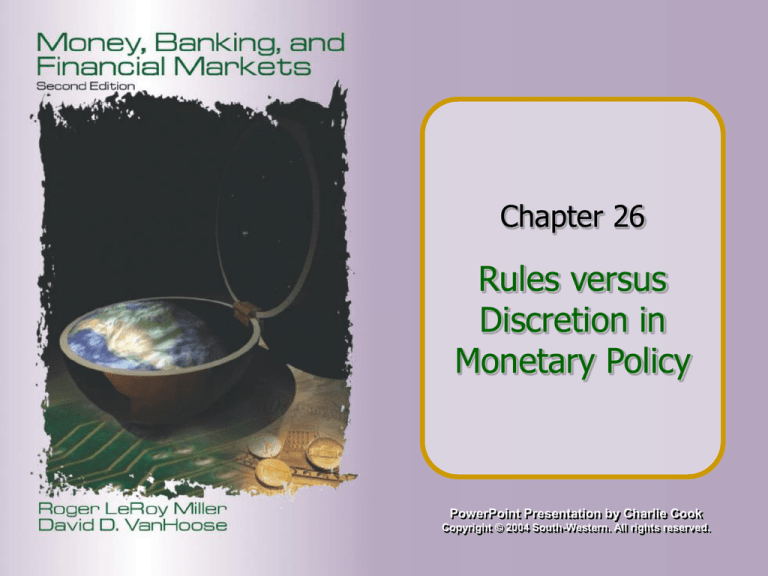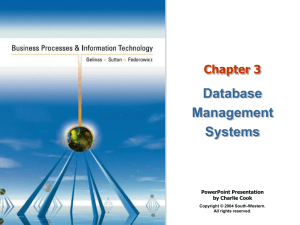
Chapter 26
Rules versus
Discretion in
Monetary Policy
PowerPoint Presentation by Charlie Cook
Copyright © 2004 South-Western. All rights reserved.
Fundamental Issues
1. What are policy time lags, and how might
they cause well-meaning monetary
policymakers to destabilize the economy?
2.
Why is monetary policy credibility a crucial
factor in maintaining low inflation?
3. How might monetary policy credibility be
achieved?
4. What is the evidence concerning the
benefits of greater central bank
independence?
Copyright © 2004 South-Western. All rights reserved.
26–2
Fundamental Issues (cont’d)
5. Do countries necessarily gain from making
their central banks more independent?
Copyright © 2004 South-Western. All rights reserved.
26–3
Constraints on Policymakers
1. In the presence of time lags, at any given point in
time policymakers have limited information about
current events.
2. Policymakers are fallible human beings who face
constraints on their abilities to recognize and
respond appropriately to changing circumstances,
particularly in light of lags in their recognition of
varying circumstances.
3. Policymakers are constrained by their lack of
certainty about the timing and size of the effects of
their policy actions.
Copyright © 2004 South-Western. All rights reserved.
26–4
Time Lags in Monetary Policy
• Policy time lags:
The time intervals between the need for a
countercyclical monetary policy action and the
ultimate effects of that action on an economic
variable.
• Recognition lag:
The interval between the need for a countercyclical
policy action and the recognition of this need by a
policymaker.
Copyright © 2004 South-Western. All rights reserved.
26–5
Types of Time Lags in Monetary Policy
• Response lag:
The interval between the recognition of a need for
a countercyclical policy action and the actual
implementation of the policy action.
• Transmission lag:
The interval between the implementation of an
intended countercyclical policy and its ultimate
effects on an economic variable.
Copyright © 2004 South-Western. All rights reserved.
26–6
How Policy Time Lags Can Make Well-Intentioned
Policy Destabilizing
Figure 26–1
Copyright © 2004 South-Western. All rights reserved.
26–7
Discretion versus Rules
(Milton Friedman)
• Discretionary policymaking:
The act of responding to economic events as they
occur, rather than in ways the policy-maker might
previously have planned in the absence of those
events.
• Policy rule:
A commitment to a fixed strategy no matter what
happens to other economic variables.
Copyright © 2004 South-Western. All rights reserved.
26–8
A Monetary Policy Game and a Theory of
Inflation
• Game theory:
The theory of strategic interactions among
individuals or institutions.
• Capacity output:
The real output that the economy could produce if
all resources were employed to their utmost.
Copyright © 2004 South-Western. All rights reserved.
26–9
Output Market Equilibrium and Policy Goals
Figure 26–2
Copyright © 2004 South-Western. All rights reserved.
26–10
Potential and Equilibrium Outcomes of a Monetary
Policy Game
Figure 26–3
Copyright © 2004 South-Western. All rights reserved.
26–11
Problems of Central Bank Credibility
• Policy credibility:
The believability of a commitment by a central bank
or governmental authority to follow specific policy
rules.
• Time-inconsistency problem:
The policy problem that can result if a policymaker
has the ability, at a future time, to alter its strategy
in a way that is inconsistent both with the desires
and strategies of private individuals and with its
own initially announced intentions.
Copyright © 2004 South-Western. All rights reserved.
26–12
Problems of Central Bank Credibility
• Inflation bias:
The tendency for the economy to experience
continuing inflation as a result of the timeinconsistency problem of discretionary monetary
policy.
• Self-fulfilling prophesy:
If the central bank releases a forecast predicting
rising inflation, then the public’s inflation
expectations will ratchet upward, thereby causing
higher inflation.
Copyright © 2004 South-Western. All rights reserved.
26–13
The Inflation Bias of Discretionary Monetary Policy
Figure 26–4
Copyright © 2004 South-Western. All rights reserved.
26–14
Making Monetary Policy Rules Credible
• Place constitutional limits on monetary policy.
• Achieve monetary policy credibility by
establishing a reputation.
• Maintain central bank independence.
• Establish central banker contracts:
A legally binding agreement between a government
and a central bank official that holds the official
responsible for the nation’s inflation performance.
Copyright © 2004 South-Western. All rights reserved.
26–15
Making Monetary Policy Rules Credible
• Appoint a “conservative” central banker:
A central bank official who dislikes inflation more
than the average citizen in society and who
therefore is less willing to induce discretionary
increases in the quantity of money in an effort to
achieve short-run increases in real output.
Copyright © 2004 South-Western. All rights reserved.
26–16
Annual Inflation Rates in the United States
SOURCES: Economic Report of the President, 2002; Economic Indicators (various issues).
Copyright © 2004 South-Western. All rights reserved.
Figure 26–5
26–17
Central Bank Independence, Average Inflation,and
Inflation Variability in Major Developed Nations
SOURCE: Alberto Alesina and Lawrence Summers, “Central Bank Independence and
Macroeconomic Performance,” Journal of Money, Credit, and Banking (May 1993): 151–162.
Copyright © 2004 South-Western. All rights reserved.
Figure 26–6
26–18
Central Bank Independence,
Average GDP Growth, and
Variability of GDP Growth
SOURCES: Carl Walsh, “Is There a Cost to Having an Independent Central Bank?” Federal
Reserve Bank of San Francisco Weekly Letter, No.94-05, February 4, 1994.
Copyright © 2004 South-Western. All rights reserved.
Figure 26–7
26–19
Central Bank Independence
and the Inflation-Output
Trade-off
SOURCE: Carl Walsh, “Output-Inflation Tradeoffs and Central Bank Independence,”
Federal Reserve Bank of San Francisco Weekly Letter, No.95-31,September 22, 1995.
Copyright © 2004 South-Western. All rights reserved.
Figure 26–8
26–20
Central Bank Independence and Average Inflation for
a Large Set of Countries
SOURCE: Roberto Chang, “Policy Credibility and the Design of Central Banks,”
Federal Reserve Bank of Atlanta Economic Review 83 (First Quarter, 1998): 4–15.
Copyright © 2004 South-Western. All rights reserved.
Figure 26–9
26–21
Inflation Rates and Unemployment Benefit Levels in
Selected Nations
SOURCES: Rafael Di Tella and Robert MacCulloch, “Unemployment Benefits as a Substitute for a
Conservative Central Banker,” Harvard Business School and London School of Economics, May 5, 2000.
Copyright © 2004 South-Western. All rights reserved.
Figure 26–10
26–22

